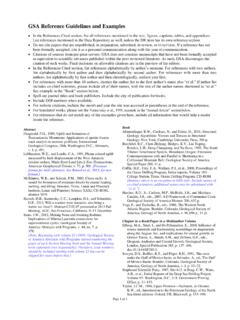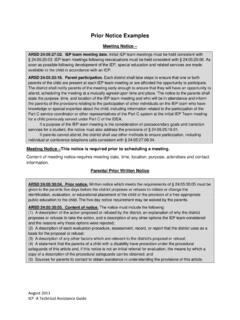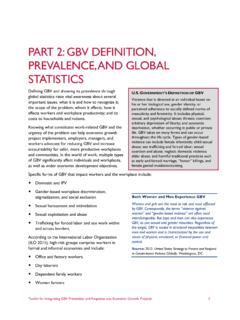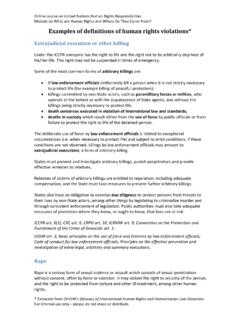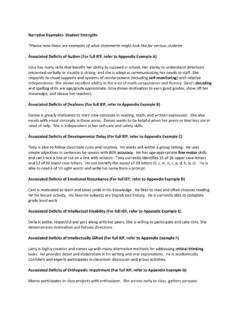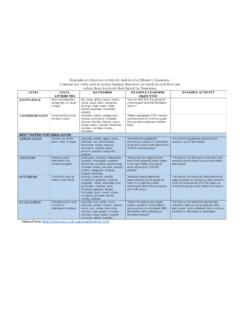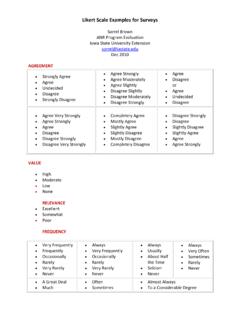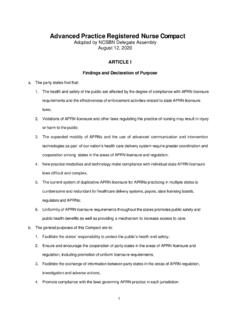Transcription of 12 HUMAN FACTORS ASPECTS OF SAFETY REPORT …
1 12 HUMAN FACTORS ASPECTS OF SAFETY REPORT ASSESSMENT. 1. Introduction 2. The General Approach to HUMAN FACTORS Assessment 3. Benchmarks 4. Proportionality 5. Pre-Construction and Pre-Operation SAFETY Reports 6. Potential Serious Deficiency and Significant Omission Appendix 12D HUMAN FACTORS Assessment Criteria and Guidance'. 1. INTRODUCTION. This guidance is for assessors completing the HUMAN FACTORS assessment and is relevant to all types of SAFETY REPORT . All HUMAN FACTORS assessment must use the criteria and guidance set out in Appendix: 12G. HUMAN FACTORS Assessment Criteria and Guidance'. HUMAN FACTORS assessment must be recorded on the form SRAM 22 HUMAN FACTORS Assessment Record'. The criteria are designed to follow in sequence the specific requirements set down in Schedule 3 of the 2015 COMAH regulations and to reflect relevant purposes set out in Regulation 8 of the same regulations. These are minimum legal requirements and are clear and enforceable (Regulation 9).
2 Demonstrations should be proportionate to the hazard and risks of identified major accident hazards. This aspect can only be decided by an operator when all the elements of Schedule 3. have been determined. The determination of proportionality is an iterative process both for an operator and an assessor Use of assessment criteria The criteria will be applied by a competent assessor against the content of the SAFETY REPORT . In this context, a competent assessor will have a good understanding of the SAFETY REPORT assessment process, its place within the HID Regulatory Model and of any stated benchmarks. a. Criteria will be met when all relevant items are included in descriptions and the necessary supporting information has been provided;. b. Criteria will be not met when all relevant items are not included in descriptions or the necessary supporting information has not been provided;. c. Criteria will be not relevant when they are not relevant to the establishment ( functional SAFETY criteria are unlikely to be relevant to a warehouse).
3 Page 144. d. Criteria will be previously met when the previous assessor recorded the criterion as met . 2. THE GENERAL APPROACH TO HUMAN FACTORS ASSESSMENT. The SAFETY REPORT demonstrates how measures taken will prevent foreseeable HUMAN failures that could lead to major accidents. The operator has a systematic approach to managing HUMAN performance based on a thorough understanding of HUMAN reliability and where the site is vulnerable to HUMAN failure. There is a system in place to: (i) Identify all SAFETY and environmentally critical tasks at the site, and specifically those which could initiate, prevent, control or mitigate the representative set of major accident scenarios;. (ii) Analyse the tasks for the potential for HUMAN failure;. (iii) Identify appropriate risk control measures matched to the type of HUMAN failure and implement them;. (iv) Identify any performance influencing FACTORS and introduce measures to optimise performance.
4 Scope of Assessment The HUMAN FACTORS specialist discipline covers a range of topics including: a. HUMAN reliability;. b. Ergonomic design of plant, equipment, working environment and tasks; and c. Optimisation of organisational performance influencing FACTORS . HUMAN Reliability (i) A structured and systematic approach to identifying and managing HUMAN failure is evidenced for both operation and maintenance functions;. (ii) HUMAN FACTORS are integrated into accident, incident and near-miss investigations. Ergonomic Design (i) HUMAN FACTORS are integrated into the operator's management of change and design processes and the operator has arrangements to integrate HUMAN FACTORS into all major modifications and new builds;. (ii) A hierarchical approach to the selection of risk control measures has been adopted and there is a clear justification for the allocation of functions to humans or to automation;. (iii) HUMAN failure is systematically addressed during the design of SAFETY instrumented systems.
5 (iv) Plant, equipment, workstations etc are designed with user capability in mind, considering construction, operation, maintenance and decommissioning tasks;. (v) The design (and upgrade) of control rooms and interfaces is user-centred;. Page 145. (vi) Alarm systems are designed and managed to take account of limitations in HUMAN performance;. (vii) Environmental effects such as working space, temperature, lighting etc, and their effects on HUMAN performance are considered in the design process. Optimisation of Organisational Performance Influencing FACTORS (PIFs). (i) Robust and systematic arrangements for the management of organisational change;. (ii) A structured framework to ensure that there are adequate numbers of competent people with realistic workloads to prevent, control and mitigate major hazards at the establishment especially during abnormal / upset conditions;. (iii) Suitable arrangements are in place to manage shift work and fatigue.
6 (iv) Effective arrangements for SAFETY critical communications including shift handover systems;. (v) A description of supervisory arrangements. Use of examples in the SAFETY REPORT Establishments should describe their systems for: (i) Identification of SAFETY critical tasks;. (ii) Task analysis and HUMAN failure analysis;. (iii) Management of organisational PIFs as appropriate. Where appropriate, establishments should consider providing examples of: (i) Task analysis and HUMAN failure analysis;. (ii) Documented assumptions underpinning assessment of HUMAN performance in SIL. and LOPAs;. (iii) Accident, incident or near-miss investigation reports;. (iv) Documents showing management of organisational PIFs as appropriate. 3. BENCHMARKS. The benchmarks for HUMAN FACTORS assessment are set out in Appendix 12G. Details of international, European and national standards, as well as relevant published guidance, are included. These will be used by all assessors to assess the SAFETY REPORT and to ensure consistency of assessment.
7 4. PROPORTIONALITY. Assessors will take a proportionate approach to SAFETY reports, which considers: (i) the potential consequences of HUMAN failure at the establishment ( the consequences of scenarios where humans could initiate, prevent, control or mitigate the major accident); and (ii) the degree of reliance on HUMAN performance. Page 146. Although there is an expectation that all establishments should follow the basic principles set out in the benchmark criteria, assessors will be proportionate regarding the extent to which the establishment provides descriptions or evidence of their management of HUMAN performance. For example , a refinery operation with complex continual processes will be expected to have a highly structured approach to task analysis, HUMAN failure analysis, and HUMAN FACTORS integration, and documented procedures for managing the full range of organisational PIFs. By contrast, a batch processor operating only one process will be expected to have a process for identifying the potential for HUMAN error and relevant PIFs and to be able to describe their processes for managing those organisational PIFs which are relevant.
8 Unless the establishment carries out a particularly novel or high risk activity, only site records that are produced as a result of applying established HUMAN FACTORS benchmark standards, or equivalent, can be requested. 5. PRE-CONSTRUCTION AND PRE-OPERATION SAFETY REPORTS. All engineering projects follow a common process of design, construction, commissioning and operation. These activities comprise sub-tasks and are spread over a schedule that can be subject to significant change, therefore the contents of pre-construction and pre- operation SAFETY reports develop over time. It is therefore difficult to select a defined point in time when a pre-construction or pre-operation SAFETY REPORT can be issued. For the purposes of HUMAN FACTORS assessment, a rolling submission is more practical than complete submissions, however, either option is acceptable. In line with HSE RR001 and Energy Institute Guidance (EI HUMAN FACTORS Briefing Note 16), it is good practice for operators to have a HUMAN FACTORS integration plan for new construction projects and major modifications, which includes: (i) The HUMAN FACTORS issues to be addressed during the project (such as staffing requirements, design for operability and maintainability, procedures, training and competence).
9 (ii) Any constraints on HUMAN FACTORS integration (such as the intention to use legacy plant and equipment);. (iii) Activities used to assess and address HUMAN FACTORS issues (such as task and HUMAN failure analysis, staffing levels assessment etc);. (iv) Dependencies to and from other development activities ( where HF is needed to inform design, or where design might impact on HF);. (v) Plans for user involvement (scheduling of user trials, prototype development, simulation etc);. (vi) Methods for monitoring progress against the plan; and (vii) Forums for negotiating HUMAN FACTORS trade-offs ( more staff may be cheaper than fully automated systems or vice versa). Page 147. Where establishments do not have a HUMAN FACTORS integration plan, they should show in their Pre-Construction and Pre-Operation SAFETY reports the measures they have taken to address these matters. Pre-Construction SAFETY Reports The type of HUMAN FACTORS information provided during the design phase would include reference to ergonomics standards, guidance and HUMAN FACTORS methods used to inform the design.
10 A HUMAN centred design approach should be adopted where humans play a key role in the safe operation and maintenance of plant and processes. Task analysis may be used as a design tool to determine where HUMAN machine interfaces are required, and to determine the likely staffing and competency requirements for operation. Design risk assessments should take account of HUMAN interactions with the system and the types of HUMAN error that could occur. This analysis can inform the appropriate allocation of function to HUMAN and/or machine. Overall, the information provided should demonstrate a structured approach to the inclusion and assessment of humans in the design. Pre-Operation SAFETY Reports The information provided at this stage in the process should deal with conformity to design'. Where humans have to be accommodated for within the design there should be a process that ensures the as constructed plant and process affords the level of accommodation intended in the design.










